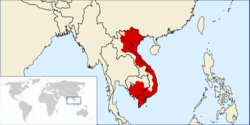Dai Nam
| Nguyễn dynasty | ||||||||||||||
| House of Nguyễn 阮朝 |
||||||||||||||
|
Empire, Kingdom (1802-1885) Protectorate of France (from 1885) |
||||||||||||||
|
||||||||||||||
|
Anthem Đăng dàn cung |
||||||||||||||
|
Việt Nam at its greatest territorial extent in 1829 under the reign of Emperor Minh Mạng
|
||||||||||||||
| Capital | Huế | |||||||||||||
| Languages | Vietnamese | |||||||||||||
| Religion | Neo-Confucianism, Buddhism, Catholicism | |||||||||||||
| Government | Absolute monarchy | |||||||||||||
| Emperor | ||||||||||||||
| • | 1802–1820 | Gia Long (first) | ||||||||||||
| • | 1926–1945 | Bảo Đại (last) | ||||||||||||
| History | ||||||||||||||
| • | Coronation of Gia Long | 1 June 1802 | ||||||||||||
| • | French invasion | 1 September 1858 | ||||||||||||
| • | Japanese invasion | 22 September 1940 | ||||||||||||
| • | Abdication of Bảo Đại | 30 August 1945 | ||||||||||||
| Area | ||||||||||||||
| • | 1830 | 575,000 km2 (222,000 sq mi) | ||||||||||||
| • | 1860 | 380,000 km2 (150,000 sq mi) | ||||||||||||
| Currency | Văn (Sapèque), Tiền | |||||||||||||
|
||||||||||||||
| Today part of |
|
|||||||||||||
The Nguyễn dynasty (Vietnamese: Nhà Nguyễn; Hán-Nôm: , Nguyễn triều) was the last ruling family of Vietnam. Their rule lasted a total of 143 years. It began in 1802, when Emperor Gia Long ascended the throne after defeating the Tây Sơn dynasty, and ended in 1945, when Bảo Đại abdicated the throne and transferred power to the Democratic Republic of Vietnam. During the reign of Gia Long, the nation officially became known as Việt Nam (越南), but from the reign of Emperor Minh Mạng onward, the nation was renamed to Đại Nam (大南, literally "Great South"). Rule was marked by the increasing influence of French colonialism; the nation was eventually divided into three parts: Cochinchina became a French colony, and Annam and Tonkin became nominally-independent protectorates.
The Nguyễn family had been one of the major families in Vietnamese history, dating back to the days of the Hero–Emperor Lê Lợi. Due to a civil war and the weakness of the Later Lê dynasty, the Nguyễn and the Trịnh (another of the major families) joined together in opposition to the Mạc. Nguyễn Kim, the leader of this alliance, was assassinated in 1545 by a servant of the Mạc. Kim's son-in-law Trịnh Kiểm, killed the eldest son of Nguyễn Kim and take over the alliance. In 1558, Nguyễn Hoàng, the second son of Nguyễn Kim was given lordship over the southern, newly conquered provinces of middle and the South of Vietnam. He ruled from the city of Huế for the rest of his life and established the dominion of the Nguyễn lords in the southern part of the country. While the Nguyễn lords, like the Trịnh, paid tribute to the Lê Emperor, the reality was they ruled, not the king. Nguyễn Hòang and his successors continually expanded their territory by making Kampuchea as protectorate, and by invading Laos, Champa and many small countries in the area. The Nguyễn lords styled themselves as "lord" (Chúa in Vietnamese).
...
Wikipedia



